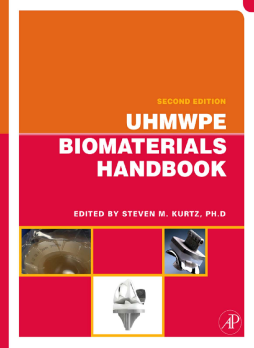
Additional Information
Book Details
Abstract
UHMWPE Biomaterials Handbook describes the science, development, properties and application of of ultra-high molecular weight polyethylene (UHMWPE) used in artificial joints. This material is currently used in 1.4 million patients around the world every year for use in the hip, knee, upper extremities, and spine.
Since the publication of the 1st edition there have been major advances in the development and clinical adoption of highly crosslinked UHMWPE for hip and knee replacement. There has also been a major international effort to introduce Vitamin E stabilized UHMWPE for patients. The accumulated knowledge on these two classes of materials are a key feature of the 2nd edition, along with an additional 19 additional chapters providing coverage of the key engineering aspects (biomechanical and materials science) and clinical/biological performance of UHMWPE, providing a more complete reference for industrial and academic materials specialists, and for surgeons and clinicians who require an understanding of the biomaterials properties of UHMWPE to work successfully on patient applications.
- The UHMWPE Handbook is the comprehensive reference for professionals, researchers, and clinicians working with biomaterials technologies for joint replacement
- New to this edition: 19 new chapters keep readers up to date with this fast moving topic, including a new section on UHMWPE biomaterials; highly crosslinked UHMWPE for hip and knee replacement; Vitamin E stabilized UHMWPE for patients; clinical performance, tribology an biologic interaction of UHMWPE
- State-of-the-art coverage of UHMWPE technology, orthopedic applications, biomaterial characterisation and engineering aspects from recognised leaders in the field
Journal of Bone and Joint Surgery
The UHMWPE Handbook is a comprehensive yet concise presentation of the important role that polyethylene has played and continues to play in the treatment armamentarium of the orthopaedic surgeon. The comprehensiveness of this volume is evidenced by the broad range of topics addressed: from the history of the clinical introduction and clinical performance of ultra-high molecular weight polyethylene in hip and knee arthroplasty to the complexities of polyethylene synthesis and processing, resin nomenclature, material degradation, analytic modeling, biomechanical and structural characterization, and currently available highly cross-linked products. Even though each one of these topics could not be dealt with in great depth, the breadth of the subject matter gives the reader an excellent overview of the field that will stimulate further reading and research. Portions of this book will be of great interest to orthopaedic residents and orthopaedic surgeons, providing them with a basic framework to understand the performance of ultra-high molecular weight polyethylene in a variety of clinical settings, including arthroplasty of the hip, knee, shoulder, and disc. This book should be read by individuals who are involved in clinical and basic research concerning polyethylene performance as well as by biomedical engineering trainees who intend to pursue a career in the orthopaedic device industry. The author and his colleagues are to be commended for compiling this information and producing an authoritative and useful resource for our specialty. - Joshua J. Jacobs, MD, Rush University Medical Center, Chicago, Illinois
